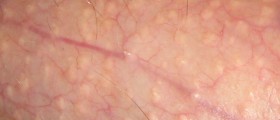hey guys don't worry a lot of times it just from rough sex you pop a blood vessel or something, or sometimes it happens your gf bites your penis head a little to hard still get checked but the way you know its a blood vessel is you get a few hours after sex its not herpes and usually your gf has a gut on her vagina..
Loading...
Thanks for the photo. In your situation, a "picture is worth a thousand words!" Imagine layer upon layer of flat tiles, piled on top of one another, at a bias, so that the tile edges don't necessarily line up to form a single seam throughout. Now imagine that there are certain areas in which those tiles are worn away, and the underlying base, which is somewhat reddish, shines through. This is what you are noticing on the head (glans) of your penis.
You are UNCIRCUMCISED, which means that those superficial "tiles" (really squamous epithelial cells, unkeritinized), have worn away due to vigorous rubbing, sucking, sexual activity, etc. If you were CIRCUMCISED, the skin of the glans would be drier and a bit more resistant to such activities (keritinized squamous epithelium).
In a few days, everything gets back to normal, so there is nothing to worry about. If itching develops, or the red spots enlarge, then you may have a skin fungus, easily treated with an antifungal cream.
My guess is that by the time you have your doctor appointment, it will have gone away by itself. NOTE, that if these red spots get worse, or look like ulcers, even if they don't hurt, it could reflect a more serious infection by a sexually transmitted infection. I somewhat doubt it, but without actually seeing you, it is difficult to know.
Hope this is helpful!
Good luck
You are UNCIRCUMCISED, which means that those superficial "tiles" (really squamous epithelial cells, unkeritinized), have worn away due to vigorous rubbing, sucking, sexual activity, etc. If you were CIRCUMCISED, the skin of the glans would be drier and a bit more resistant to such activities (keritinized squamous epithelium).
In a few days, everything gets back to normal, so there is nothing to worry about. If itching develops, or the red spots enlarge, then you may have a skin fungus, easily treated with an antifungal cream.
My guess is that by the time you have your doctor appointment, it will have gone away by itself. NOTE, that if these red spots get worse, or look like ulcers, even if they don't hurt, it could reflect a more serious infection by a sexually transmitted infection. I somewhat doubt it, but without actually seeing you, it is difficult to know.
Hope this is helpful!
Good luck
Loading...
could have nothing to do with the sex i would get your self seen for Type 2 diabetes (non-insulin dependent diabetes) it can lead to thrush if you suger levils are out of whack. This is a most troublesome problem and you have my sympathy. Diabetes certainly does predispose patients to recurrent infections and it is important they are treated thoroughly.
Thrush infection due to the yeast candida is a common problem. Canesten cream is a valuable and effective treatment, but because the condition is recurring so frequently it would be wise to try alternatives such as Nystan creams and an oral treatment called Diflucan.
Thrush infection due to the yeast candida is a common problem. Canesten cream is a valuable and effective treatment, but because the condition is recurring so frequently it would be wise to try alternatives such as Nystan creams and an oral treatment called Diflucan.
Loading...
search balanitis its not an std
relates to simple hygene of the penis and foreskin
easy to fix
relates to simple hygene of the penis and foreskin
easy to fix
Loading...
Spots on the penis
Written by Dr John Dean, specialist in sexual medicine
Men are understandably concerned when they notice spots on the penis. They are frequently worried they may have a sexually transmitted disease or some form of cancer. They may equally be worried about the appearance of their penis and what their sexual partner might think of it.
Are they common?
Spots on the penis are very common and most do not have a serious cause. However, some do and it is important to seek prompt medical advice if you are concerned.
This article describes some of the causes of spots on the penis, but reading it and examining your own penis is no substitute for examination by a doctor!
What should I do?
Unless you think you have a sexually transmitted disease (STD), the first place to seek advice about spots on the penis is from your GP.
If you are too embarrassed to discuss it with your family doctor, or think you might have an STD, you can seek confidential advice from your local genito-urinary medicine (GUM) clinic. You don't need a referral letter from your GP, but it is advisable to first telephone the clinic. To find out when they are open, and whether you need an appointment.
In the UK, they are usually listed in the telephone directory under 'Health Service' or 'Hospitals'. Or you can ring your nearest large hospital and ask where the GUM clinic is.
Types of spots
Spots on the penis can be divided into groups according to their appearance.
* Ulcers: ulcers appear as craters on the skin and represent a full-thickness loss of skin (epidermis). There is frequently a crust, clear liquid (serum) or pus in the crater.
* Papules: papules are small (less than 1cm diameter) lesions (lumps) raised above the skin surface.
* Plaques: plaques are raised, flat-topped lesions, greater than 1cm in diameter.
Ulcers
Single penile ulcers frequently have a serious cause and it's important to seek prompt medical advice.
Possible causes:
* primary syphilis: a single, round, painless ulcer on the penis or scrotum is characteristic of the first attack of syphilis (primary syphilis). It is caused by a spirochaete (spiral-shaped) bacterium called Treponema pallidum. The diagnosis must be confirmed by laboratory tests. It is an infectious STD.
* chancroid, granuloma inguinale, lymphogranuloma venereum: these are tropical diseases that cause a single, painless, foul-smelling ulcer. The diagnosis must be confirmed by laboratory tests. They should be suspected in men with a history of sexual contact in tropical areas. There has been a mini-outbreak of lymphogranuloma venereum (LGV) in Britain in 2008-9 especially in London and Brighton. They are all infectious STDs.
* penile cancer (squamous cell carcinoma): may appear as a painless, irregular genital ulcer. Early diagnosis and treatment is essential and may be life-saving.
Multiple penile ulcers are more common and may have a less serious cause. However, seeking prompt medical attention is still important. They can be divided into two groups: acute - present for less than two weeks - and chronic - present for more than two weeks.
Acute
* Herpes simplex: this is the commonest cause of genital ulceration. It is caused by Herpesvirus hominis type two, or sometimes type one - the virus usually associated with oral herpes or cold sores. Herpes is characterised by recurrent bouts of genital vesicles, like small blisters, which rapidly break down to form small, painful ulcers. It is highly infectious and usually sexually transmitted. The first episode is usually associated with an acute feverish illness, which may be quite severe. The diagnosis must be confirmed by laboratory tests. Acute episodes can be effectively treated with antiviral medicines, such as aciclovir, although recurrences are common. Stress or other feverish illnesses may precipitate such recurrences.
* Secondary syphilis: multiple irregular, shallow, painless grey ulcers, sometimes described as 'serpiginous', like a snail track on the penis, are characteristic of secondary syphilis. It is caused by a spirochaete bacterium called Treponema pallidum. A flu-like illness and a blotchy, red rash usually accompany it over the body. As with primary syphilis, the diagnosis must be confirmed by laboratory tests. It is an infectious STD.
* Apthous ulcers: these are small, shallow, painful ulcers that most commonly appear in the mouth, but can also affect the penis. Typically, they have a grey centre surrounded by a bright red halo. They occur in crops and resolve without treatment. They can easily be confused with herpes simplex ulcers, so laboratory tests are necessary to reliably distinguish the two. They are not infectious and their cause is unknown.
Chronic
* Pemphigus: this usually affects other parts of the body, frequently starting in the mouth, but may be restricted to the penis. It appears as fragile, thin-walled blisters that break down to form ulcers. These are often painful and may itch. There are a variety of different forms; the most severe type may affect the whole body and is life threatening. It is caused by a breakdown in the adhesion between different layers of the skin. Prompt diagnosis and treatment is essential.
* Behçet's disease: an inflammatory disorder affecting the skin, joints, nerves, eyes and other body systems.Symptoms may include large, deep and painful ulcers on the penis and scrotum, but is always accompanied by mouth ulcers. It is a potentially serious condition and prompt diagnosis and treatment is essential. It is not infectious.
* Reiter's syndrome: an inflammatory condition that occurs with generalised arthritis. About a quarter of affected men have small, ulcerated plaques around the glans and foreskin. It can also affect muscles, the eyes and nails. It is caused by an abnormal immune response to a gut or genital infection. It may follow a prolonged, relapsing course, but can be treated. Reiter's syndrome is not itself infectious, but the germs that might cause it are. Some of them can be sexually transmitted.
Papules
Most penile papules do not have a serious cause, but some are infectious and may lead to more serious conditions. An early penile cancer may also appear as a papule before ulcerating. It is important to seek prompt medical advice about penile papules.
* Molluscum contagiosum: a common, benign, infectious viral disease affecting the skin and mucous membranes. It is a common skin condition in childhood when it is transmitted through ordinary peer contact. In adults it may be sexually transmitted and this is probably the commonest cause of penile molluscum in adult men. It appears as multiple, small, dome-shaped papules, often with a central depression or plug. A curd-like discharge can be squeezed from them. It may disappear without treatment, but freezing or cautery will usually get rid of it. Molluscum contagiosum is a marker for 'unsafe' sexual practices in adulthood and those affected should be screened for HIV
* Hair follicles and sebaceous (sweat) glands: these are a normal part of the skin's anatomy and are commonly found on the penile shaft, particularly on the ventral surface (underside). They may be visible as small nodules or might only be felt as small lumps in the skin. They will have a hair arising from them that reveals their true nature. They are quite normal.
* Pearly penile papules: multiple, small (about 1-3mm) papules running around the circumference of the crown of the glans penis. They typically develop in men aged 20 to 40, and around 10 per cent of all men are affected. They may be mistaken for warts, are not infectious and require no treatment.
* Fordyce spots: small (1-5mm) bright red or purple papules that can appear on the glans, shaft or scrotum and usually affect younger men. They may occur as a solitary lesion, but frequently appear in crops of 50 to 100. They are painless and not itchy, but may cause embarrassment because of their appearance, or a fear that they might be sexually transmitted. They are abnormally dilated blood vessels, covered by thickened skin. They may bleed if injured or even during intercourse. They are not infectious and their cause is unknown. Although a number of approaches have been tried, there is no simple, reliable treatment to remove them. Troublesome bleeding spots can be sealed with a device that uses a small electric current (electrocautery).
* Psoriasis: most commonly affects other parts of the body, particularly the knees, elbows and scalp, but occasionally first appears on the penis, usually on the glans or inner surface of the foreskin. Psoriasis appears as thickened red papules or plaques with a well-defined edge. In uncircumcised men, and at other sites, it has a scaly surface. It rarely causes irritation. It is caused by an abnormality of skin production and can be inherited. It is unsightly, but rarely serious. There are a number of effective treatments available, such as steroid creams and calcipotriol cream (Dovonex).
* Warts: a number of different types of wart may appear on the penis. Genital warts are caused by human papilloma virus (HPV) and are infectious. They may be single or multiple, skin-coloured, pink or brown, with a moist surface. HPV infection is associated with the development of cervical and anal cancer, so it is important that sexual partners are screened for evidence of infection. They can be treated in a variety of ways, from skin paints to cautery, but are sometimes very difficult to eradicate.
Plaques
Penile plaques do not usually have a serious cause, but some are infectious and others may develop into more serious conditions: Erythroplasia of Queyrat, lichen sclerosis and balanitis xerotica obliterans may lead to the development of penile cancer.Make sure you seek prompt medical advice about penile plaques.
* Balanitis and posthitis: balanitis is an inflammatory condition of the glans penis. Posthitis is an inflammatory condition of the foreskin. Symptoms include local irritation, burning and a red rash. Sometimes the skin appears to be peeling off as if scalded. Bacteria and yeasts such as candida can cause it. It is more common in older men and those with diabetes. Balanitis is infectious and may be sexually transmitted. It can be treated with appropriate antimicrobial creams.
* Erythroplasia of Queyrat: appears as a sharply demarcated bright red plaque with a velvety surface. It is usually painless, and not itchy. It is an early manifestation of penile cancer and needs prompt diagnosis and treatment. Excision of the affected area is usually curative. It is not infectious.
* Zoon's plasma cell balanitis: Zoon's balanitis appears as a bright red, shiny-surfaced plaque on the glans or inner surface of the foreskin. It is usually painless but may be accompanied by itching. The cause is unknown. It may respond to application of steroid cream, but frequently recurs. Circumcision is curative, but not essential. It is a harmless condition but can be confused with the much more serious condition of Erythroplasia of Queyrat. It is not infectious.
* Lichen sclerosis and balanitis xerotica obliterans: lichen sclerosis appears as white plaques on the glans, foreskin or shaft of the penis. It usually has no symptoms, although burning and irritation have been reported. Balanitis xerotica obliterans is a severe form of lichen sclerosis affecting the foreskin of uncircumcised men. The opening or edge of the foreskin is firm and has a white scarred appearance. It is quite inelastic and will not pucker open as it is retracted. This may interfere with passing urine or sex. Both conditions may, rarely, lead to penile cancer and circumcision may be necessary. They are not infectious.
* Psoriasis: see above, under papules.
* Eczema: most commonly affects other parts of the body, but occasionally it may first appear on the penis. In such cases, it may be a skin reaction to an irritant that is better be described as dermatitis. Eczema appears as diffuse red plaques with a poorly defined edge and finely scaled surface. It frequently causes quite severe irritation. It can be caused by infection or local reaction to skin injury from chemicals or radiation. There are a number of effective treatments available, such as steroid creams. It is not infectious.
Written by Dr John Dean, specialist in sexual medicine
Men are understandably concerned when they notice spots on the penis. They are frequently worried they may have a sexually transmitted disease or some form of cancer. They may equally be worried about the appearance of their penis and what their sexual partner might think of it.
Are they common?
Spots on the penis are very common and most do not have a serious cause. However, some do and it is important to seek prompt medical advice if you are concerned.
This article describes some of the causes of spots on the penis, but reading it and examining your own penis is no substitute for examination by a doctor!
What should I do?
Unless you think you have a sexually transmitted disease (STD), the first place to seek advice about spots on the penis is from your GP.
If you are too embarrassed to discuss it with your family doctor, or think you might have an STD, you can seek confidential advice from your local genito-urinary medicine (GUM) clinic. You don't need a referral letter from your GP, but it is advisable to first telephone the clinic. To find out when they are open, and whether you need an appointment.
In the UK, they are usually listed in the telephone directory under 'Health Service' or 'Hospitals'. Or you can ring your nearest large hospital and ask where the GUM clinic is.
Types of spots
Spots on the penis can be divided into groups according to their appearance.
* Ulcers: ulcers appear as craters on the skin and represent a full-thickness loss of skin (epidermis). There is frequently a crust, clear liquid (serum) or pus in the crater.
* Papules: papules are small (less than 1cm diameter) lesions (lumps) raised above the skin surface.
* Plaques: plaques are raised, flat-topped lesions, greater than 1cm in diameter.
Ulcers
Single penile ulcers frequently have a serious cause and it's important to seek prompt medical advice.
Possible causes:
* primary syphilis: a single, round, painless ulcer on the penis or scrotum is characteristic of the first attack of syphilis (primary syphilis). It is caused by a spirochaete (spiral-shaped) bacterium called Treponema pallidum. The diagnosis must be confirmed by laboratory tests. It is an infectious STD.
* chancroid, granuloma inguinale, lymphogranuloma venereum: these are tropical diseases that cause a single, painless, foul-smelling ulcer. The diagnosis must be confirmed by laboratory tests. They should be suspected in men with a history of sexual contact in tropical areas. There has been a mini-outbreak of lymphogranuloma venereum (LGV) in Britain in 2008-9 especially in London and Brighton. They are all infectious STDs.
* penile cancer (squamous cell carcinoma): may appear as a painless, irregular genital ulcer. Early diagnosis and treatment is essential and may be life-saving.
Multiple penile ulcers are more common and may have a less serious cause. However, seeking prompt medical attention is still important. They can be divided into two groups: acute - present for less than two weeks - and chronic - present for more than two weeks.
Acute
* Herpes simplex: this is the commonest cause of genital ulceration. It is caused by Herpesvirus hominis type two, or sometimes type one - the virus usually associated with oral herpes or cold sores. Herpes is characterised by recurrent bouts of genital vesicles, like small blisters, which rapidly break down to form small, painful ulcers. It is highly infectious and usually sexually transmitted. The first episode is usually associated with an acute feverish illness, which may be quite severe. The diagnosis must be confirmed by laboratory tests. Acute episodes can be effectively treated with antiviral medicines, such as aciclovir, although recurrences are common. Stress or other feverish illnesses may precipitate such recurrences.
* Secondary syphilis: multiple irregular, shallow, painless grey ulcers, sometimes described as 'serpiginous', like a snail track on the penis, are characteristic of secondary syphilis. It is caused by a spirochaete bacterium called Treponema pallidum. A flu-like illness and a blotchy, red rash usually accompany it over the body. As with primary syphilis, the diagnosis must be confirmed by laboratory tests. It is an infectious STD.
* Apthous ulcers: these are small, shallow, painful ulcers that most commonly appear in the mouth, but can also affect the penis. Typically, they have a grey centre surrounded by a bright red halo. They occur in crops and resolve without treatment. They can easily be confused with herpes simplex ulcers, so laboratory tests are necessary to reliably distinguish the two. They are not infectious and their cause is unknown.
Chronic
* Pemphigus: this usually affects other parts of the body, frequently starting in the mouth, but may be restricted to the penis. It appears as fragile, thin-walled blisters that break down to form ulcers. These are often painful and may itch. There are a variety of different forms; the most severe type may affect the whole body and is life threatening. It is caused by a breakdown in the adhesion between different layers of the skin. Prompt diagnosis and treatment is essential.
* Behçet's disease: an inflammatory disorder affecting the skin, joints, nerves, eyes and other body systems.Symptoms may include large, deep and painful ulcers on the penis and scrotum, but is always accompanied by mouth ulcers. It is a potentially serious condition and prompt diagnosis and treatment is essential. It is not infectious.
* Reiter's syndrome: an inflammatory condition that occurs with generalised arthritis. About a quarter of affected men have small, ulcerated plaques around the glans and foreskin. It can also affect muscles, the eyes and nails. It is caused by an abnormal immune response to a gut or genital infection. It may follow a prolonged, relapsing course, but can be treated. Reiter's syndrome is not itself infectious, but the germs that might cause it are. Some of them can be sexually transmitted.
Papules
Most penile papules do not have a serious cause, but some are infectious and may lead to more serious conditions. An early penile cancer may also appear as a papule before ulcerating. It is important to seek prompt medical advice about penile papules.
* Molluscum contagiosum: a common, benign, infectious viral disease affecting the skin and mucous membranes. It is a common skin condition in childhood when it is transmitted through ordinary peer contact. In adults it may be sexually transmitted and this is probably the commonest cause of penile molluscum in adult men. It appears as multiple, small, dome-shaped papules, often with a central depression or plug. A curd-like discharge can be squeezed from them. It may disappear without treatment, but freezing or cautery will usually get rid of it. Molluscum contagiosum is a marker for 'unsafe' sexual practices in adulthood and those affected should be screened for HIV
* Hair follicles and sebaceous (sweat) glands: these are a normal part of the skin's anatomy and are commonly found on the penile shaft, particularly on the ventral surface (underside). They may be visible as small nodules or might only be felt as small lumps in the skin. They will have a hair arising from them that reveals their true nature. They are quite normal.
* Pearly penile papules: multiple, small (about 1-3mm) papules running around the circumference of the crown of the glans penis. They typically develop in men aged 20 to 40, and around 10 per cent of all men are affected. They may be mistaken for warts, are not infectious and require no treatment.
* Fordyce spots: small (1-5mm) bright red or purple papules that can appear on the glans, shaft or scrotum and usually affect younger men. They may occur as a solitary lesion, but frequently appear in crops of 50 to 100. They are painless and not itchy, but may cause embarrassment because of their appearance, or a fear that they might be sexually transmitted. They are abnormally dilated blood vessels, covered by thickened skin. They may bleed if injured or even during intercourse. They are not infectious and their cause is unknown. Although a number of approaches have been tried, there is no simple, reliable treatment to remove them. Troublesome bleeding spots can be sealed with a device that uses a small electric current (electrocautery).
* Psoriasis: most commonly affects other parts of the body, particularly the knees, elbows and scalp, but occasionally first appears on the penis, usually on the glans or inner surface of the foreskin. Psoriasis appears as thickened red papules or plaques with a well-defined edge. In uncircumcised men, and at other sites, it has a scaly surface. It rarely causes irritation. It is caused by an abnormality of skin production and can be inherited. It is unsightly, but rarely serious. There are a number of effective treatments available, such as steroid creams and calcipotriol cream (Dovonex).
* Warts: a number of different types of wart may appear on the penis. Genital warts are caused by human papilloma virus (HPV) and are infectious. They may be single or multiple, skin-coloured, pink or brown, with a moist surface. HPV infection is associated with the development of cervical and anal cancer, so it is important that sexual partners are screened for evidence of infection. They can be treated in a variety of ways, from skin paints to cautery, but are sometimes very difficult to eradicate.
Plaques
Penile plaques do not usually have a serious cause, but some are infectious and others may develop into more serious conditions: Erythroplasia of Queyrat, lichen sclerosis and balanitis xerotica obliterans may lead to the development of penile cancer.Make sure you seek prompt medical advice about penile plaques.
* Balanitis and posthitis: balanitis is an inflammatory condition of the glans penis. Posthitis is an inflammatory condition of the foreskin. Symptoms include local irritation, burning and a red rash. Sometimes the skin appears to be peeling off as if scalded. Bacteria and yeasts such as candida can cause it. It is more common in older men and those with diabetes. Balanitis is infectious and may be sexually transmitted. It can be treated with appropriate antimicrobial creams.
* Erythroplasia of Queyrat: appears as a sharply demarcated bright red plaque with a velvety surface. It is usually painless, and not itchy. It is an early manifestation of penile cancer and needs prompt diagnosis and treatment. Excision of the affected area is usually curative. It is not infectious.
* Zoon's plasma cell balanitis: Zoon's balanitis appears as a bright red, shiny-surfaced plaque on the glans or inner surface of the foreskin. It is usually painless but may be accompanied by itching. The cause is unknown. It may respond to application of steroid cream, but frequently recurs. Circumcision is curative, but not essential. It is a harmless condition but can be confused with the much more serious condition of Erythroplasia of Queyrat. It is not infectious.
* Lichen sclerosis and balanitis xerotica obliterans: lichen sclerosis appears as white plaques on the glans, foreskin or shaft of the penis. It usually has no symptoms, although burning and irritation have been reported. Balanitis xerotica obliterans is a severe form of lichen sclerosis affecting the foreskin of uncircumcised men. The opening or edge of the foreskin is firm and has a white scarred appearance. It is quite inelastic and will not pucker open as it is retracted. This may interfere with passing urine or sex. Both conditions may, rarely, lead to penile cancer and circumcision may be necessary. They are not infectious.
* Psoriasis: see above, under papules.
* Eczema: most commonly affects other parts of the body, but occasionally it may first appear on the penis. In such cases, it may be a skin reaction to an irritant that is better be described as dermatitis. Eczema appears as diffuse red plaques with a poorly defined edge and finely scaled surface. It frequently causes quite severe irritation. It can be caused by infection or local reaction to skin injury from chemicals or radiation. There are a number of effective treatments available, such as steroid creams. It is not infectious.
Loading...
Male yeast infection.
it can give bumps (bluster), make it itch, red and painful, and clumps of white yeast.
it can be passed back and forth with heterosexual couples.
Males can also have non-symptomatic genital yeast infections, which can pop up with symptoms if stressed and run down.
go to the doctor and get treatment, I believe they will offer you a cream.
this is what I believe it is and sounds like.
it can give bumps (bluster), make it itch, red and painful, and clumps of white yeast.
it can be passed back and forth with heterosexual couples.
Males can also have non-symptomatic genital yeast infections, which can pop up with symptoms if stressed and run down.
go to the doctor and get treatment, I believe they will offer you a cream.
this is what I believe it is and sounds like.
Loading...
Hey I'm not sure if what I have is the same thing..
24yo male - uncircumcised
Had unprotected sex 7-10 days ago w/ girl i didn't really know
Recently on Avalox and Fluorinase for sinusitis (Ie finished avalox course 2 days ago).
Yesterday had some tightness in my foreskin in a 'ring' shape.. slight redness and a slight itchiness. This morning that is gone but I have got small either non-raised or barely raised red spots uniformly all over the head of my penis. they itch a very little bit.. I've put some Lotriderm on it this morning as I suspect it is some sort of candida/yeast based rash from either unprotected sex with someone who had thrush, or as a complication from having broad-spectrum antibiotics.
Any ideas anyone?!? Could it be something else?
24yo male - uncircumcised
Had unprotected sex 7-10 days ago w/ girl i didn't really know
Recently on Avalox and Fluorinase for sinusitis (Ie finished avalox course 2 days ago).
Yesterday had some tightness in my foreskin in a 'ring' shape.. slight redness and a slight itchiness. This morning that is gone but I have got small either non-raised or barely raised red spots uniformly all over the head of my penis. they itch a very little bit.. I've put some Lotriderm on it this morning as I suspect it is some sort of candida/yeast based rash from either unprotected sex with someone who had thrush, or as a complication from having broad-spectrum antibiotics.
Any ideas anyone?!? Could it be something else?
Loading...
im having similiar issues cept i had unprotected sex and like three hours later i had a burning sensation and a little itch and when i loks there were little red dots under the foreskin and on the tip .. could this be cause from a reaction to the girl i had sex withs like bodily fluids i guess you would call them. cuz i didnt have tiem to come home and shower right after
Loading...
oh god, I have the same thing. I just had unprotected sex with a girl who I think may have been lying when she said she only had had sex with her 1 long term bf before me. I was looking for a forum like this, I see a lot of questions but not many answers. I'm getting worried.
Just to clarify, mine is under my foreskin on the head of my penis only, its just a bunch of little red dots. Doesn't itch or hurt or anything yet, but its only been a couple of days, hopefully it just goes away...
Anyone know what this could possibly be?
Just to clarify, mine is under my foreskin on the head of my penis only, its just a bunch of little red dots. Doesn't itch or hurt or anything yet, but its only been a couple of days, hopefully it just goes away...
Anyone know what this could possibly be?
Loading...
wow, i dont think its any of the previous diseses, but i have the red dots aswell.... so what is it?
Loading...
I'm 16 I had sex like in December it was unprotected nd today I noticed I had red dots on my penis this is really freaking me out does anybody know wat is wrong with me:0?
Loading...
I'm 16 I had sex like in December it was unprotected nd today I noticed I had red dots on my penis this is really freaking me out does anybody know wat is wrong with me
Loading...
I have some rash under my penis foreskin sometimes which easily appears when rubbed. After a few hours you wont even notice the skin has been broken. It itchs mildly sometimes. May go for a month without appearing and sometimes appear twice a week. Please help, what could this be?
Loading...

















